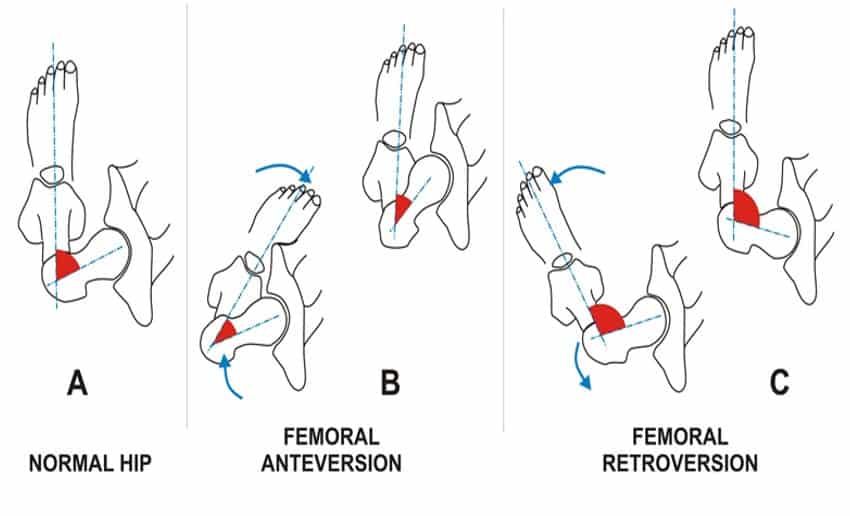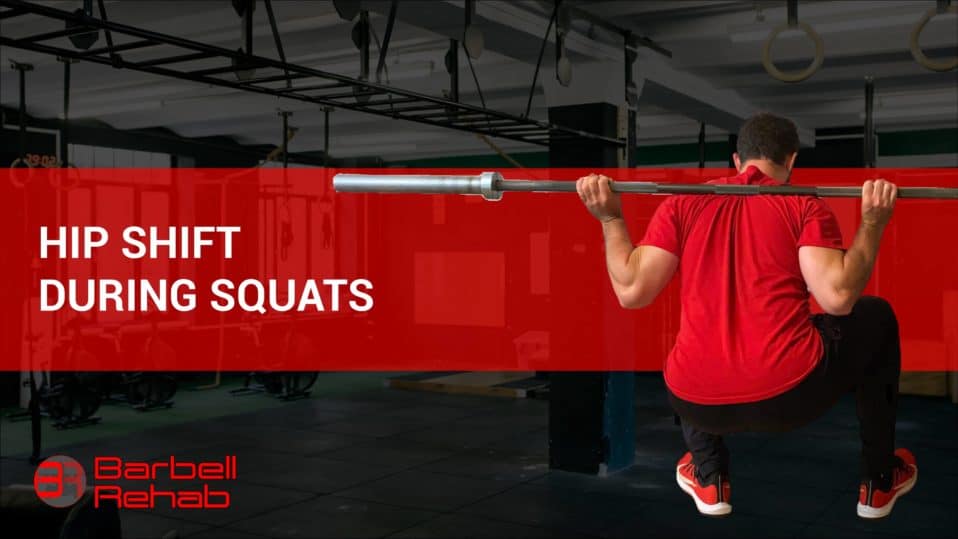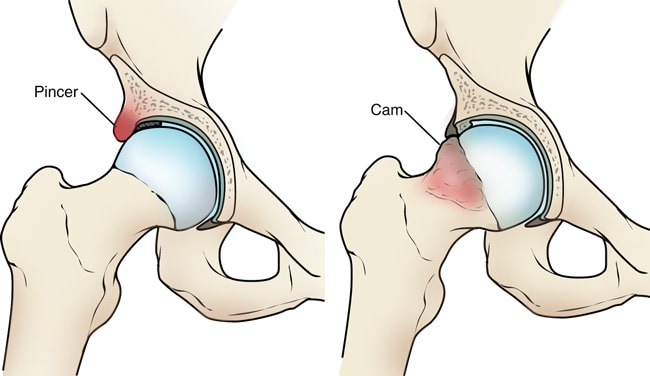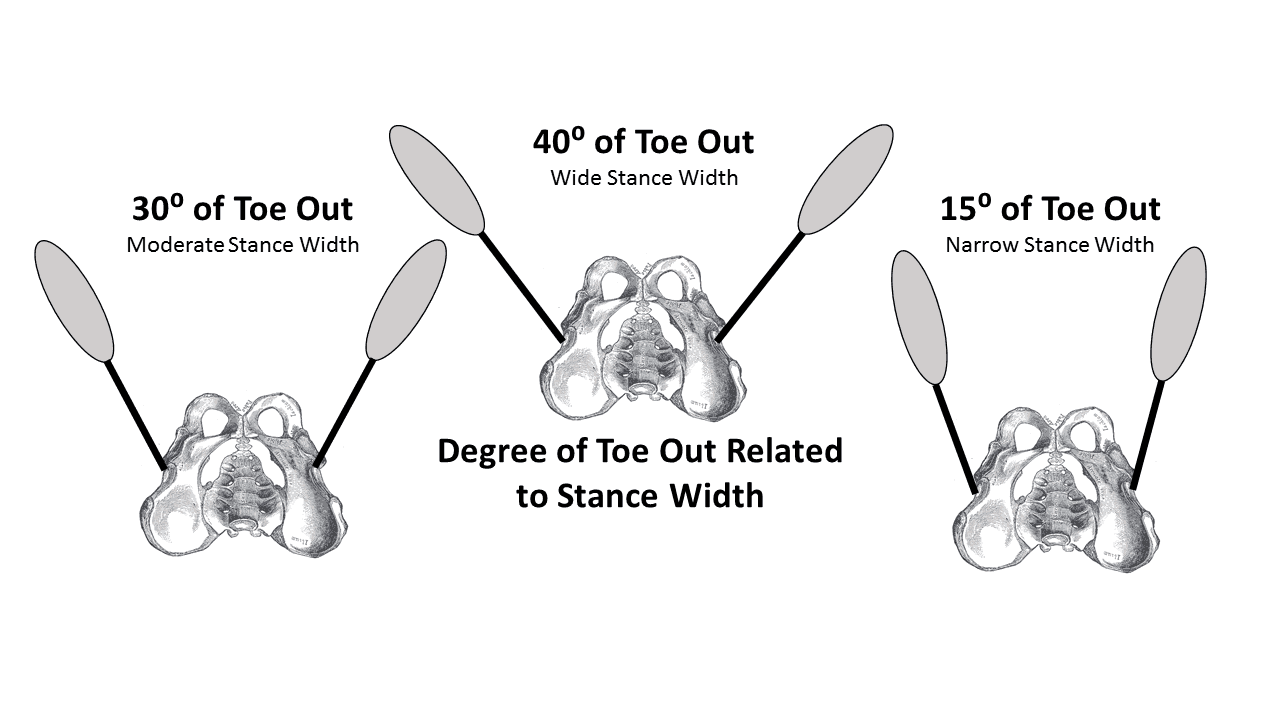Hip shift during squats is a very common occurrence for many barbell athletes. A hip shift occurs when your hips move laterally towards one side or the other at the bottom of the squat.
The decision to correct this or not is going to be based on a multitude of factors. In this article, we will talk about why a hip shift occurs during squats and if you should spend time correcting it or not!
Why Do People Hip Shift During Squats?
There are many reasons why you might be shifting to one side at the bottom of your squat. These include:
- An ankle or hip mobility limitation on one leg, which will cause you to shift to the non-affected side.
- One leg is stronger than the other, so you naturally shift to the stronger side.
- Pain in one leg that causes you to push more and shift towards your non-affected leg.
- A past injury or pain where you learned to push with your non-affected leg, and now you continue to do this out of habit.
- Different amounts of femoral version in one hip compared to the other, so you may shift to one side depending on what stance you’re using (aka foot positioning)
In addition to figuring out the root cause of the shift, you also should ask yourself if it’s only happening at heavier loads and whether it’s causing you current pain or not. Often times, small shifts that don’t cause any pain don’t even need corrected!
Why Not All Hip Shifts NEED Corrected
If you have a consistent, minor hip shift in the bottom of your squat that is the same from rep to rep, no matter what weight is on the bar, I'd be VERY hesitant to correct this. Why? This just might be the way you squat.
The body is highly adaptable, and if your progress isn't hindered and you aren't having any pain or symptoms, "correcting" the hip shift may end up doing more harm than good!
However, if you're having pain during the squat, and your hip shift worsens as you fatigue or increase the load, then it may be time to intervene. Let's dig into the various reasons why you might have a hip shift during squats.
Hip Shifting Due to a Mobility Restriction
If you find that you have a hip shift during squats even with lighter loads and warm up weights, you may have a unilateral mobility limitation at either the hip or ankle.
Both limited ankle dorsiflexion or limitations in hip rotation mobility can cause you to shift towards the opposite side during the squat.
For example, if you have limited right hip internal rotation, you may find yourself shifting to the LEFT at the bottom of the squat. A right ankle dorsiflexion limitation may cause the same left-sided shift.
Now that you know a mobility limitation can cause a hip shift, let’s talk about how to assess for this. You can’t just “assume” you have a mobility limitation without actually assessing for it.
As mentioned, limitations in both hip external rotation and/or internal rotation could cause a hip shift in the squat to the opposite side.
Assessing and Improving Hip External Rotation Mobility
To see if you have a hip external rotation limitation, you can lie down on your back, and put one foot on top of your opposite knee. This is basically a modified FABER test.
If you see a significant difference between your legs (in other words, is one knee a lot further from the ground than the other?) you may have a hip external rotation mobility limitation.
You can also perform this test seated as well to gather more data. If one leg is much more difficult to get into position, you may have a hip external rotation limitation.
If you find that this is the case, you can work on improving your hip external rotation by simply turning the assessments into exercises as described in the video below.
Assessing and Improving Hip Internal Rotation Mobility
Another mobility limitation that can limit squat depth and cause a hip shift to the non-affected side is hip internal rotation. To check for this, you can lie on your back, move your feet out and then attempt to touch your knees together. Does one feel tighter than the other?
If so, then you may have a hip internal rotation mobility deficit. To work on this, you can just, again, modify this assessment into a hip internal rotation mobility drill very easily as described in the video below.
Assessing and Improving Ankle Dorsiflexion Mobility
Another reason you could be shifting at the bottom of the squat is an ankle dorsiflexion mobility restriction. Before we get into how to assess this, we should talk about how different squat variations require different amounts of ankle dorsiflexion.
Low bar squats with a wide stance require very little dorsiflexion. So if an ankle dorsiflexion limitation is causing a shift during a low bar squat, it would have to be a pretty severe limitation.
On the other hand, front squats require much more ankle dorsiflexion, where even a minor mobility restriction at the ankle can contribute to a hip shift.
To see if you have a ankle dorsiflexion limitation, you can perform the half-kneeling knee to wall ankle dorsiflexion test (see video below).
If you find a major difference between one side AND you’re also performing an ankle dorsiflexion intensive squat variation, you may want to wear an elevated heel lifting shoe and work on improving ankle dorsiflexion mobility.
For a few examples of mobility drills to improve ankle dorsiflexion, check out here and here.
Hip Shifting Due to a Recent Injury, Surgery, or Pain
Another reason people may hip shift in the squat is due to a recent or past injury or surgery. For example, upon reintegrating the squat pattern after a total knee replacement or ACL repair, we would expect one to naturally favor and shift TOWARDS the non-affected lower extremity.
This usually happens on a subconscious level, as the body is still in “protect” mode.
One way to make sure this shift doesn’t become permanent years after a surgery or injury, is to make sure you don’t load it too quickly in the beginning.
If all you did was load up the squat after an ACL repair, and neglected to train unilateral lunge variations, the “good” leg will definitely do more work and create a shift.
Instead, a better way to approach this would be to reintegrate the squat pattern at a low load, where minimal to no shifting occurs AND to simultaneously train lunge and other single-leg variations to specifically target the affected lower extremity.
This one-two punch of training both the bilateral movement AND teasing out and specifically focusing on the affected lower extremity will be your best bet at limiting any current of future hip shifting during the squat.
Chronic Hip Shifting After a Past Injury, Surgery, or Pain
If not taken care of early, many people can continue to hip shift away from a once injured lower extremity for years, even after they’ve returned to full function and pain has completely resided. How does this happen?
Basically, if you allow a hip shift to occur in the early stages of rehab, and you continue to reinforce it with more and more load, the body and brain will basically adapt this as your “new normal.”
So the next question you might ask is...Is this necessary a bad thing? Does a chronic hip shift need “corrected”? If I continue to squat like this, will it lead to injury? Unfortunately, the answer isn’t so simple.
One aspect I like to look at, as a guide for whether you should focus on correcting this chronic hip shift or not is this: Is the hip shift occurring to the same extent on all of your reps? Or does it continually worsen with higher volumes and higher intensities?
Should You Fix a Chronic Hip Shift During Squats?
As mentioned earlier in the article, if you have a small hip shift (how do we even define “small” anyways) that is STABLE, a.k.a it’s to the same extent with both lighter and heavier intensities, I might not correct this at all.
If on the other hand, your hip shift continues to worsen with load, volume, and fatigue, this is when I’d recommend intervening.
If form is breaking down or changing with higher loads, this may introduce a stimulus to your body that it’s not prepared for, leaving you at increased risk of injury.
If this sounds like you, I’d recommend training the squat at a volume and intensity right BELOW where the shift occurs and also simultaneously dosing in the following two things: tempo unilateral lower extremity work and RNT Squats.
Fixing Hip Shift in the Squat with the Rear-Foot Elevated Split Squat and RNT
If you’re finding yourself shifting more and more as the load or volume increases, you may still have an underlying STRENGTH deficit to work on.
Training a tempo lunge variation will really force you to push through the weaker leg. I really like to use a tempo rear-foot elevated split squat variation for this.
In addition to getting more squat volume in right below the intensity where the shift occurs and performing a tempo rear-foot elevated split squat, I also like to dose in some reactive neuromuscular training (RNT) work.
As mentioned early, if you’ve been shifting for quite a while, you body adopts this as your new “normal” so visual and verbal cues might not be enough to fix hip shift in the squat.
This is where RNT comes in. RNT is a way to provide an external resistance is a very specific way to encourage your body to auto-correct a movement pattern.
In the case of squatting, you can attach a band around your hips and have someone attempt to lightly pull your body in the SAME direction that you are shifting.
Your body when then “auto-correct” by pushing more through the affected lower extremity to subconsciously correct a shift. Check out the video below for a more in-depth explanation.
The combination of performing more squat volume right below where a hip shift occurs and dosing in tempo RFESS and RNT work is one heck of a triple threat for fixing hip shift in the squat that worsen with load.
Hip Shifting Due to Suboptimal Foot Positioning
The last reason why you might hip shift during the squat, is lack of ideal foot positioning. Here’s the deal. Everyone is going to squat with a different stance width and degree of toe out.
There is no one uniform way to squat. So a “good” position for one person, may be “poor” positioning for another.
If you’ve ever heard that everyone should squat with their toes straight forward, or everyone should adopt a moderate stance with a slight toe out...it’s simply not true.
To take it an even step FURTHER, some of you may even feel more comfortable with turning one toe out more than the other, and this may be completely natural based on your hip anatomy.
As a quick overview on hip anatomy. people will display different degrees of femoral version, or the way the femoral neck is rotated relative to the femoral condyles (knee).

P.S These are all variations of "normal"
Some may be retroverted (rotated outward) and some may be anteverted (rotated inward). This degree of version will correlate with someone’s squat stance.
In general, those with excessive retroversion will feel more comfortable with their toes turned OUT during the squat, and those with more anteversion will feel better with their toes pointed more forward.
What happens if you take a highly retroverted individual and try to fit them into a narrow stance, toes forward squat? It doesn’t feel that great.
It may cause a pinching sensation in the front of the hip or even pain. So these folks will naturally gravitate towards a toes turned out squat stance.
Hip Version and Uneven Squat Stances
So how does retroversion and anteversion relate to hip shifting during squats? Here’s the thing. Some people can have DIFFERENT amounts of version in one hip compared to the other.
For example, if one hip is retroverted and one hip is anteverted, this person’s “natural” squat stance may include MORE toe out on the retroverted side!
Furthermore, if you try and “correct” this and force the retroverted side to “match” the toe forward position of the anteverted side, this may cause a shift AWAY from the retroverted side in the bottom of the squat!
Whoa...crazy right? So how do you assess for hip version? You can use Craig’s test, shown in the video below.
If you’re dealing with a hip shift in the squat, what you want to look for here is to see if there is a significant difference in femoral version from one side to the other.
If there is, try squatting with MORE toe out on the retroverted side and see if this remedies your hip shift.
Tying it All Together and Concluding Thoughts
The decision of whether to correct a hip shift or not, and HOW to correct it requires a systematic approach. You can’t just assume it’s a mobility limitation and start haphazardly working on ankle dorsiflexion. And you can’t just assume it even needs corrected at all.
So if you’re hip shifting during squats, in general:
- If you have a minor hip shift with all loads and volumes and it’s pain-free and not hindering progress...leave it alone
- If you have a significant hip shift with all loads and volumes, try altering your stance width and degree of toe out to see if this helps.
- If changing stance width and degree of toe out doesn't correct the hip shift, it’s time to assess for a mobility deficit
- If there’s a mobility deficit, work on correcting it, and dose in some tempo RFESS and RNT work
- If you’re only shifting at higher loads or volumes, work on getting more volume in right below where the shift occurs and also assess for a mobility deficit. Then, proceed to the bullet point above.
Fixing hip shifts in the squat that may not even warrant "fixing", or just randomly doing mobility work won’t get you anywhere. Instead, follow the guide above to systematically address your hip shift during squats!





